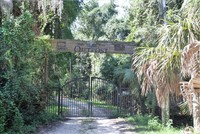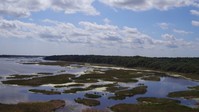St. Johns County staff maintains position in latest round of comments on PVC's Vista Tranquila
St. Johns County staff sent its latest round of comments to Ponte Vedra Corporation (PVC) regarding the company’s Vista Tranquila development application Aug. 1.
In the comments, county staff most notably writes that it disagrees with PVC that The Outpost property is designated as Residential-C or that the Residential-C designation of certain adjacent property should be extended to the subject property.
“Staff does not find that the applicant has demonstrated that the proposed PUD (Planned Unit Development) is consistent with the Comprehensive Plan and the subject property’s Future Land Use designation of Conservation,” said county staff in the comments. “In particular, staff does not find that the applicant has demonstrated that the exact boundaries of the land use designation of the subject property on the Future Land Use Map require interpretation on the basis that the location of a specific boundary is not clearly delineated on the Future Land Use Map.”
The county has maintained this overall position since the debate over PVC’s development of The Outpost began a few years ago. PVC, a Gate Petroleum subsidiary, is proposing to rezone its 99 acres of Conservation property known as The Outpost from Open Rural to Planned Unit Development (PUD) to build a 66-home subdivision there known as Vista Tranquila. The Outpost property is located at the end of Neck Road and adjacent to the Guana Tolomato Matanzas National Estuarine Research Reserve (GTMNERR).
The county has consistently asked that PVC’s PUD application be accompanied by a Comprehensive Plan amendment to change the Conservation designation. PVC argues that a plan amendment is not required to process the application. The company and its defense say the land use designation is conditional and requires future boundary adjustments based on environmental field surveys. They also argue the county has consistently approved such boundary adjustments in the past, determining that development on non-jurisdictional portions of such property may be developed consistent with the surrounding property, which in the case of The Outpost is Residential-C. In its most recent comments, county staff said these examples cited by PVC are different compared to the company’s Vista Tranquila application. County representatives did not wish to elaborate on how they're different due to the pending litigation between the two parties.
PVC submitted its responses to the county’s review of its controversial development project June 30 and has since been awaiting the county’s next steps. Now that PVC has received the county's latest comments, Attorney Lynn Pappas said the company is disappointed that the county continues to treat this property differently from other similarly situated properties.
“I would say the staff position that is articulated that the conditional Conservation land use designation doesn’t apply to this particular piece of private property…we have not found any evidence in the record to support that staff position,” said Pappas. “The staff has not provided any evidence or justification for that position, certainly not in the responses they’ve offered, most recently and frankly for the last three years that we’ve been working with them on the matter.
“If they intended to exclude The Outpost from the conditional conservation land use designation that governs the other private properties in the county and put this entire Outpost parcel within Conservation of land use of its own, then we would believe that the record in the county’s proceedings or in the county some place, somehow, somewhere, would reflect that,” she continued. “We’ve not been able to find anything that supports that position.”
Also notable in the county’s comments is its continued concerns for adverse impacts on the lands that surround the proposed development. Staff said that the GTMNERR and the Guana Wildlife Management Area have “the potential for impact for light, noise, runoff, loss of habitat and other kinds of issues that come with residential development.”
Pappas said PVC has complied with the land development code, as well as all regulatory agencies that have jurisdiction on the property, including the Florida Department of Environmental Protection (DEP). As a result, she doesn’t see how the Vista Tranquila development would be any more impactful than what’s already been developed in the area.
“I don’t know of any reason why the residences that we construct, which would be less dense than Neck Road is today, that have more environmental protection because we’re required to have master storm water systems and meet OFW (Outstanding Florida Waters) water quality standards, would be any different or any more impactful than what’s there now or any other parcel of property adjacent to that environment and to that preservation area,” she explained.
Jane West, an attorney representing those who have formed the nonprofit group Save Guana Now to fight the development, disagrees.
“I don’t see how you can say with a straight face that sticking 66 single family residential units on a peninsula of untouched property in this very pristine environment is not impactful,” said West. “All you have you to do is look at the property, go out there physically and walk around the area, and you’ll see very clearly that this will be impactful to the adjacent area.”
Also within the county’s comments, staff says the directly accessed roadway segment known as Link 72, or Mickler Road from CR 210 to SR A1A, is currently classified as "deficient" with the total committed traffic at 124.7 percent of the approved peak hour service volume capacity. If Link 72 is impacted at 1 percent or more of the approved peak hour service, the comments read, then "mitigation" will be required. The comments also state that right and left turn lanes will be required at the intersection of Mickler and Neck roads based on the project’s daily trip generation.
Pappas said none of the traffic comments surprised her, explaining that the traffic discussion is based on technical analysis and a refinement process that the company is still working through with the transportation division.
In addition, county staff asks PVC for several technical requests in the document, such as providing details regarding the construction of the development’s community park and how the company plans to protect a gopher tortoise burrow on the property, as well as determining the number and location of “specimen” trees on the property.
Pappas said the timeline moving forward is dependent on how long it takes PVC to assemble responses and determine whether additional inquiries need to be made to county staff. Then, she said, the company will decide if it needs more written comments from the county or if they’re ready to request that a public hearing be scheduled. The county’s communications team confirmed this process, reiterating that Planning and Zoning Agency and Board of County Commission hearings have yet to be scheduled.
Overall, Pappas said the timeframe in which the county has managed the comment process over the last several months is “fairly typical.” She said, however, the overall timeframe over the past few years has been frustrating.
“It was preceded by three years of basically not getting anything accomplished,” she said. “So yes, we’re frustrated, and I think we don’t feel like this land owner is being treated fairly. But we’re going through the process, and the county is honoring the judge’s order to process it in a timely fashion. That’s where we are now.”










